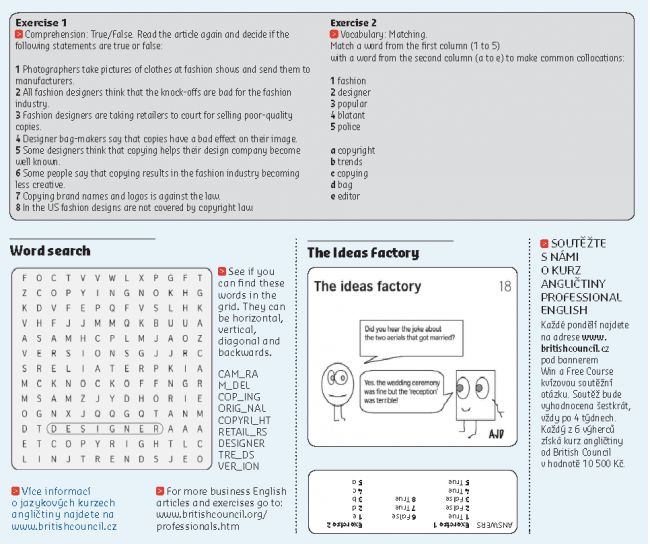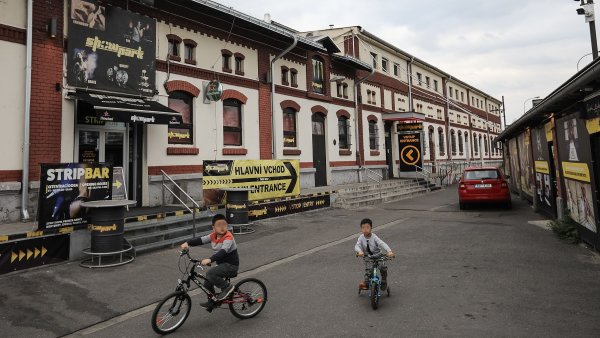Fashion industry by Carolyn Hardwick
Flattery or piracy? The fashion industry can't decide.
The audience gasps. Fashion editors scribble notes. Cameras flash. As the model sashays down the catwalk it's clear to everyone that this is going to be the must-have dress of the season. And long before the applause has died down, photographs of the dress have been sent to manufacturers, who will then copy and produce 'knock-off' versions for a fraction of the designer's price tag.
Blatant theft of ideas, or flattering imitation and extra publicity? The fashion industry, and even designers themselves, can't decide if the massive knock-off industry is a good or bad thing. Some fashion houses are taking retailers to court for selling copies that they say are too close to the original article. They argue that they are not only losing sales, but copies that are inferior in quality affect their reputation. Designer bag companies in particular claim that poorly made knock-off bags that fall apart all too soon have a negative effect on their image.
Other designers feel that the proliferation of cheap copies in high street stores can only be a good thing. They argue that those who buy a 50 euro imitation would never be able to afford the 5,000 euro original anyway, and that a design that is copied by all popular retailers increases the profile of the fashion house that produced it. Everyone knows who designed the original, and so no harm is done. There is also a theory that copying benefits the fashion industry by increasing creativity. As new designs rapidly become popular trends, designers have to come up with even newer ideas to keep the real 'fashionistas' happy.
Counterfeiting, which involves the blatant copying of brand names and logos, is of course outlawed. So would it be possible to legislate against the greyer area of knock-offs? European designers have some protection under law, but that hasn't stopped a thriving knock-off business in high street stores. Designers in the USA have no protection at the moment, as fashion design is historically considered a craft, not an art, and outside the scope of copyright protection. Policing copyright on fashion would be particularly difficult. Knock-off versions can be in the shops within two or three days of a fashion show, before the original is even available for sale, so how can you prove who had the idea first?
Exercise 1
Comprehension: True/False. Read the article again and decide if the following statements are true or false:
1 Photographers take pictures of clothes at fashion shows and send them to manufacturers.
2 All fashion designers think that the knock-offs are bad for the fashion industry.
3 Fashion designers are taking retailers to court for selling poor-quality copies.
4 Designer bag-makers say that copies have a bad effect on their image.
5 Some designers think that copying helps their design company become well known.
6 Some people say that copying results in the fashion industry becoming less creative.
7 Copying brand names and logos is against the law.
8 In the US fashion designs are not covered by copyright law.
Exercise 2
Vocabulary: Matching.
Match a word from the first column (1 to 5)
with a word from the second column (a to e) to make common collocations:
1 fashion
2 designer
3 popular
4 blatant
5 police
a copyright
b trends
c copying
d bag
e editor
Soutěžte s námi o kurz angličtiny professional english
Každé pondělí najdete na adrese www.britishcouncil.cz
pod bannerem Win a Free Course kvízovou soutěžní otázku. Soutěž bude vyhodnocena šestkrát, vždy po 4 týdnech. Každý z 6 výherců získá kurz angličtiny od British Council v hodnotě 10 500 Kč.
 Přidejte si Hospodářské noviny
mezi své oblíbené tituly
na Google zprávách.
Přidejte si Hospodářské noviny
mezi své oblíbené tituly
na Google zprávách.
Tento článek máteje zdarma. Když si předplatíte HN, budete moci číst všechny naše články nejen na vašem aktuálním připojení. Vaše předplatné brzy skončí. Předplaťte si HN a můžete i nadále číst všechny naše články. Nyní první 2 měsíce jen za 40 Kč.
- Veškerý obsah HN.cz
- Možnost kdykoliv zrušit
- Odemykejte obsah pro přátele
- Ukládejte si články na později
- Všechny články v audioverzi + playlist





